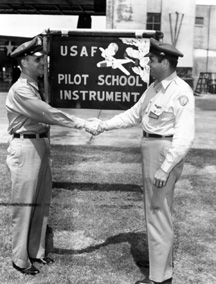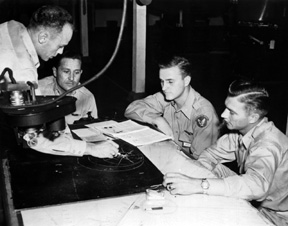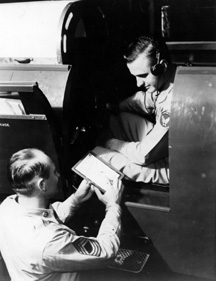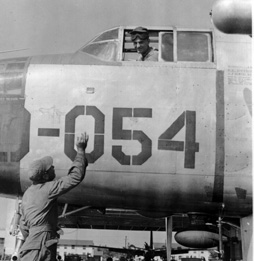|
Relating to The Earl E. Myers Story Chapter 18 — Reassigned To Reconnaissance Duty |
|||||||
| I have no idea why I was selected to transfer to McGuire AFB along with about 20 others pilots, Navigators, Bombardiers, and all other crew specialities. Recon — What a job. Just fly and check the weather and thing's like that. No action. It was not long before I found out different about that — LIKE BIG TIME!. The Bombers have no target information unless it is done by reconnoesence first. Of course old outdated map's from National Geographic, etc. are O.K. "BUT" All target's must be overflown as a single sortie to gather the necessary information for pre-bomb damage assement of the target and post-damage assesment for possiable futher action. Also running the borders of Comunist Block countries is no bowl of strawberries. Gathering photo coverage and ECM intellengence information for the bombers so they can penatrate at the weakest link in the chain of radar coverage. USAF RB-29s, RC-130s, RB-47 and other prop and jet jet aircraft were involved. The U.S. Navy, U.S. Army — all branch's of the service — had Intellegence equipment and capability.
The Wing was just starting to man the crews, both flight and ground. Zero-timed RB-29s were starting to be delivered from Kelly Air Force Base in San Antonio. They were equipped with Curtis Electric Props and Curtis Wright fuel-injected engines, all new to the military. Also all the latest in technology in aerial cameras, Electronic Counter Measure (ECM) equipment. New tires also. No Firestones. Crew formation was accomplished and off we went to San Antonio in a C-54. We attended "Difference's" ground school on the new equipment. It was trial and error completeing the functional flight checks. We had growing pains for sure. We had a lot of problems with the props at first. No one had training on proper maintenance. I nearly bought the farm landing at Kelly AFB where the zero time was accomplished. On our approach, the #4 prop went into reverse at about 300 ft and I made contact with the ground very firmly. We started to veer off to the right of the runway thru the grass and hit an upraised portion of a drainage ditch and bounced over the ditch. I thought the aircraft would break into small pieces. It came to a stop and the alarm bell was sounding somewhere during this fiasco.We evacuated the aircraft rapidly. We had a full Army Colonel on board as a passenger and he was sitting on the toad stool. He asked what he was supposed to do as I pushed him out of the aircraft and almost fell on top of him. The aircraft was not damaged other than both tires on the right side were burnt to the core from the braking. The tire marks were still visible a year later. The #4 prop blades could be twirled around individually. They were completely stripped from there internal gears, all because a cannon plug was not safety-wired and had vibrated loose on the flight from McGuire to Kelly Field, San Antonio. We were delivering the aircraft to Kelly for a new installation and added cameras. Our crew returned to McGuire on a C-54 that was scheduled. At McGuire AFB the 91st Strategic Reconnansence Wing, under the Commandof Col.Tommy A. Stead, SN #395A, (Terrible Tommy). Col. Ross Greening as the Director of Operations. He was a Doolitle Raider and was shot down and a POW. He launched off the Enterprise along with Doolittle on the famous first B-25s off of the Enterprise, destination, "TOKYO". Ross was a shootdown and POW. He also was a Medal of Honor recepient. I had the pleasure of checking him out in the RB-29. He had attended the required ground training (MTD) and off we went. He had no problem with the aircraft and soloed it after about 20 hours. He was intelligent enough to have an I.P. on board with him and guess who? It was a pleasure to be associated with him, not because on the Medal of Honor, but because he was a Man of Honor. He was also an accomplished artist, specializeing in military aircraft, and has at least two of his paintings displayed in the USAF Museum at Wright Patterson, AFB. I was non-current in the B-25 and he receiprocated by supervising 3 take off and landings.with me. He sprinkled the Holy Water on me and off I went. Ross and I would transport an RB-29 crew to Kelly AFB, San Antonio, TX, to pick up another zero timed RB-29. If we were to pick one up, and were useing a B-25, we would do the getting there and then he would have someone else on board take the B-25 back to McGuire. Into the RB-29 left seat for him and he was good. A real tickler for the check list, a perfectionist and a very professional. Not over-confident in any way, just professional. We had two AT-6s at McGuire, and, on occasion, we would go out and chase each other around the sky, HOG HIGH again. O.K. Now we are off for the new assigned home to the newest equipped aircraft in the USAF. Man, this is living. We at once started max range missions with four fuel bladders, two in each bomb bay. we were shooting for 4,000 nautical mile range with reserve. We had it. It took a fine tooth comb on the flight engineer's part to squeeze the last drop out of the fuel and the engines. Our crew chief was M/SGT James Lolly. He crewed the B-17 that I operated at McGuire while waiting for the RBs to come into service. he was pro. Jim and I are still good friends after 54 years. Jim lives in Topeka, Kansas. In the July of 1949, with little forewarning, I suddenly found myself selected to attend the USAF Instrument Flight Instructors Training Course, then located at Barksdale AFB, LA. This 16 week training program was a real “plumb,” an opportunity to solidify my base as a career USAF Officer and hone my skills as a pilot. I jumped at the chance and headed off for Barksdale, not realizing that plans were in the works to flesh out the staffing of the 31st SRS, then located at Kadena AB, Okinawa. The Instrument School used B-25s for the instrument trainers and I was already familiar with them after operating them in advanced flight training. We put the hood on at take off and never saw the ground until we landed and were taxing back in to the ramp. It was great training. The Link Trainer was used and as we all remember it was a toy compared to the flight simulators that we now have. |
|||||||
 |
|||||||
 |
|||||||
|
Right: Lt. Myers receives instruction in Link Trainer procedures from instrument training instructor. |
|||||||
 |
|||||||
 |
|||||||
|
|
|||||||
|
to start engines. |
|||||||
| As I waited for further orders after completion of the Instrument Flight School, I went to Base Ops at Barksdale and made myself available to fly as the opportunities presented themselves. I was flying AT-6s, C-45s, B-25s, B-26s, F-51s, B-29s, C47s and C-46s as they were so logged in my AF Form 5. Most were test hops that were generated from the 3rd Echelon Maintenance Facility located at Barksdale. Flying all those different aircraft was really fun. Especially the F-51. I had an old crew chief show me how to start the engine and off I went (Into The Wild Blue Yonder). By the fall season of 1949 I learned that the 91st Wing was transferring from McGuire to Barksdale. Before the Wing’s departure from McGuire, they cut orders for my transfer to the 31st SRS, Kadena AB, Okinawa. It would seem that my assignment to the Instrument School and then on to the 31st SRS was all part of a larger plan of action that, as yet, had not been made public knowledge. End of Chapter 18 — Go to Chapter 19 Go to EEM Introduction —Chapter 1 — 2 — 3 — 4 — 5 — 6 — 7 — 8 |
|||||||